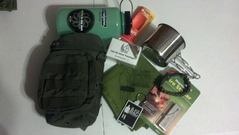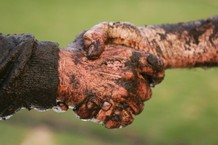 People often ask me to sell them "survival kits." I'm not a fan of the idea. Your survival requirements are far too personal and specific for a prefabricated kit. Invariably, something gets missed or left out, or, worse yet, the company selling the kit loads it with the cheapest junk they can get in an effort to maximize profits. It is my philosophy that you have to build your kit yourself. I can guide you, help you figure out your needs, but I'd be doing a disservice if I tried to do it for you. You need to have 100% confidence in every item in your kit. It isn't what you buy, it's what you learn, know, and do. There is no substitute. But you guys want packages, and as the saying goes - the customer is always right. Here's my plan: I'm going to start assembling product bundles. I'll put together packages of items that make sense and function well together, quality items I use myself, at a discounted price. These bundles will save you a few bucks, meet customer demand, and coincide with my philosophy that you have to build your kit yourself. Here's the first of these combos: Dave asked for a small bundle to cover fire and water. Obviously, I want you to add to this, but here's a bundle to get you started. (There's two of these combos ready to ship.) Combo includes: H2O Pouch, MOLLE compatible, insulated, with a small outer pocket to hold everything together. Nalgene Bottle, 32 oz, Glow-in-the-dark, wide mouth bottle can be used to protect the other items in the combo. Light My Fire Spork, bright orange so it doesn't get lost, this is my favorite camp chow utensil. Safe-Light PALight Survival flashlight, white LED, the best small light in an emergency. Check out the article here. Stainless Steel Cup, nests with the bottle and can be used to boil water. Magnesium Fire Starter, reliable fire starting capability. Paracord Bracelet, convenient multi use cordage, can be disassembled to make a sling or fire bow/drill. BBR Bandana, has a million uses, including pre-filter for your water. BBR Keychain, because they're cool, and I know you want one. Total value: $87 Black Bag Resources Price: $75 What should you add? Start with Tincture of Iodine, available at your local pharmacy, which can be used to treat wounds and treat (decontaminate) water the same way Iodine tabs would. A small "first aide" kit with some adhesive bandages and ointment is always handy. A small sample or travel sized bottle of hand sanitizer has multiple purposes. You can wrap some duck tape around the bottle or add a flat pack. A piece of tin foil can be used as a wind screen or a lid for the steel cup. A heavy duty zip seal bag can be used to catch or carry additional water and takes up very little space when empty. Make some fire starters from dryer lint or cotton balls and petroleum jelly. Finally, a piece of hacksaw blade as explained here. And there's no reason to stop there. As I've stated earlier, you know best what you need. You might even add this combo to a larger kit. ORDER HERE Basic Special Forces doctrine dictates that there are three simple questions to ask when recruiting a "Guerrilla Chief." I know. That's a pretty hefty opening line, so let's break it down. The mission of the US Army's Special Forces is to act as a force multiplier by recruiting, training, and deploying local or indigenous peoples to fight as allies in a specific theater. Because locals are most often fighting as guerrilla units, their leaders are referred to as "Guerrilla Chiefs," since it is often social leaders or tribal chieftains who take command positions within the newly formed guerrilla units. It is those same leaders that SF teams must recruit first to gain the alliance of the clan, tribe, or community group. SF teams must assimilate to local culture to gain trust, while guiding the locals towards their goal. What's the point of this article if you aren't recruiting for a rebel guerrilla force? You can apply these same concepts and the 3 questions in your daily life when negotiating deals and partnerships. Keep in mind that you want an affirmative answer to all three questions.  Question # 1: Do you have a secure backyard? To the SF team, the answer to this question immediately presents two pieces of information. First, whether or not it is safe to set up shop in this area. A secure rear means they won't have to constantly look over their shoulder for outside threats. It also means they can focus on the task at hand without the interruptions of fighting off those outside threats. Second, it tells them whether or not they are actually dealing with the head honcho of the area. There may be additional feuds in the area that are of little tactical concern to the SF team, other than ensuring they are working with the strongest group in the area. In your personal and professional dealings, you need to know whether it is safe to proceed and if the person you are working with can actually advance your goals. Are you dealing with a self-important mid-level blowhard or the boss? The boss can actually effect changes and make decisions. The boss can also protect your six from other competitors or detractors. Can they provide you with real insight on how to achieve your goal? If not, they aren't providing you with the rear security you need to succeed, because they aren't really in command of their "backyard."  Question #2: Do we have a common goal today, recognizing that tomorrow may be different? Alliances are temporary. Accept it. The SF team knows that today they are working with tribesmen to secure intelligence on an enemy. In the future, they may return to fight those same tribesmen to stop their drug trade. Larger goals and politics will shift, so the SF team focuses on one objective with their current ally. They foster the relationship based on that goal and steer all activities back to it's success. They also understand that they might have to befriend some unsavory characters to achieve the objective, and will tolerate what might otherwise be unacceptable. Likewise, you can't expect to be in 100% agreement with your allies all the time. The key in personal and professional dealings is to avoid burning bridges unnecessarily. You might partner with someone on a project this month, then offer competing proposals next month. Then, in two months you need their expertise on a third project. Remember to foster the relationship and reinforce that success is mutually beneficial.  Question #3: Are you willing to kill someone? Whether referring to the SF team or your personal and professional dealings, an affirmative answer to this question will let you know that your ally is fully committed to achieving the goal. The obvious difference is that this question may be a literal one for the SF team, but is a figurative one for you. Either way, you're looking for an affirmative commitment to success, despite potential hardships or personal conflicts. You need to know that your ally is willing to do what it takes, so be certain that they are sincere in their commitment. Expect some hesitation, because it might not be (and in some cases should not be) an easy decision to make. But, if their answer is negative, end the partnership immediately. By not committing to success, they are committing to failure, or at least not investing in success. If your ally isn't invested, they will have nothing to lose from your failure, so there may be little motivation to succeed. Think of it as the carrot and the stick- the carrot represents the benefits success, and the stick represents the personal investments lost in failure. Get them invested. Get them committed. Succeed. |
Black Bag Resources Blog
News, projects, products, and tips from the owner. Archives
September 2022
Categories
All
|



 RSS Feed
RSS Feed